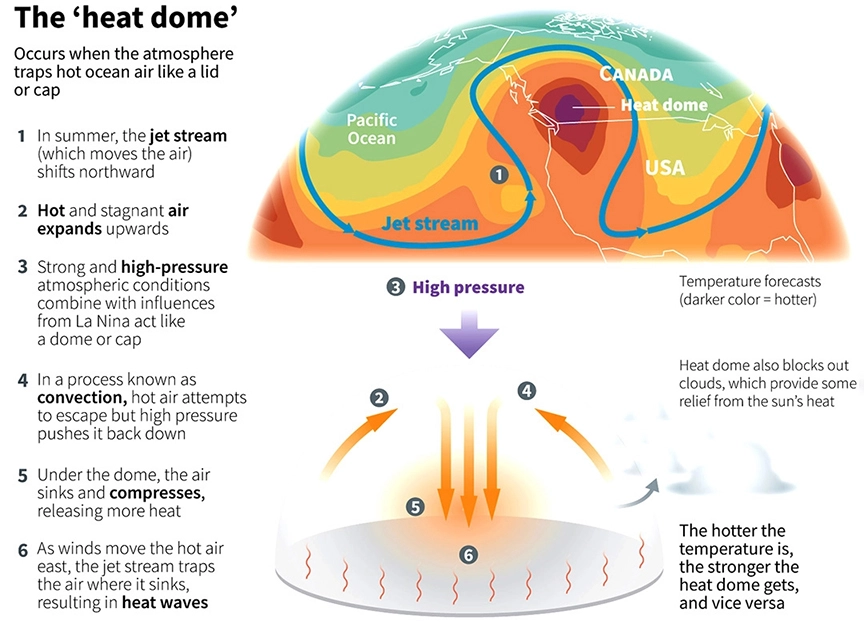Heat Dome
For Prelims: Heat Dome, Jet Stream, Climate Change
For Mains: Important Geophysical Phenomena
Why in News?
Several countries in Europe recorded their hottest January weather ever in 2023 with temperatures 10 to 20 degrees Celsius above average.
- These included Poland, Denmark, the Czech Republic, the Netherlands, Belarus, Lithuania and Latvia.
- Experts said that the continent is experiencing an extremely warm spell because of the formation of a heat dome over the region.
- In 2021, a heat dome formed over western Canada and the US, causing deadly heat waves.
- Another heat dome settled over the US in September 2022 and raised temperatures to a new high.
What is a Heat Dome and Heat Wave?
- Heat Dome:
- A heat dome occurs when an area of high-pressure traps warm air over a region, just like a lid on a pot, for an extended period of time.
- The longer that air remains trapped, the more the sun works to heat the air, producing warmer conditions with every passing day.
- Heat domes generally stay for a few days but sometimes they can extend up to weeks, which might cause deadly heat waves.
- Scientists suggest that any region of high pressure, whether a heat dome or not, forces air to sink and once it reaches the ground, it gets compressed and becomes even warmer.
- Moreover, when air sinks, it gets drier and further raises the temperature of the area.
- Heat Domes and the Jet Stream:
- The heat dome’s formation is related to the behaviour of the jet stream.
- Jet streams are relatively narrow bands of strong wind in the upper levels of the atmosphere
- The jet stream is believed to have a wave-like pattern that keeps moving from north to south and then north again.
- When these waves get bigger and elongated, they move slowly and sometimes can become stationary.
- This is when a high-pressure system gets stuck and leads to the occurrence of a heat dome.
- Although heat domes are likely to have always existed, researchers say that climate change may be making them more intense and longer.
- They suggest with the rising temperatures, it is expected that the jet stream will become more wavy and will have larger deviations, causing more frequent extreme heat events.
- The heat dome’s formation is related to the behaviour of the jet stream.
What are the Causes of Formation of Heat Dome?
- Change in Ocean Temperature: The phenomenon begins when there is a strong change (or gradient) in ocean temperatures.
- In the process known as convection, the gradient causes more warm air, heated by the ocean surface, to rise over the ocean surface.
- As prevailing winds move the hot air east, the northern shifts of the jet stream trap the air and move it toward land, where it sinks, resulting in heat waves.
- Change in Atmospheric Pressure: Heat waves begin when high pressure in the atmosphere moves in and pushes warm air toward the ground. This effect is fueled by heat rising from the ocean, creating an amplification loop.
- The high-pressure system pressing down on the ground expands vertically, forcing other weather systems to change course.
- It even minimizes wind and cloud cover, making the air more stifling.
- This is also why a heat wave parks itself over an area for several days or longer.
- The high-pressure system pressing down on the ground expands vertically, forcing other weather systems to change course.
- Climate Change: The rising temperatures lead to hotter weather. Heat waves have been a regular phenomenon on land.
- However, global warming has caused them to be hotter with a longer duration and an increased frequency.
- Scientists studying the climate tend to agree that the heat waves occurring today are more likely to be a result of climate change for which humans are responsible.
